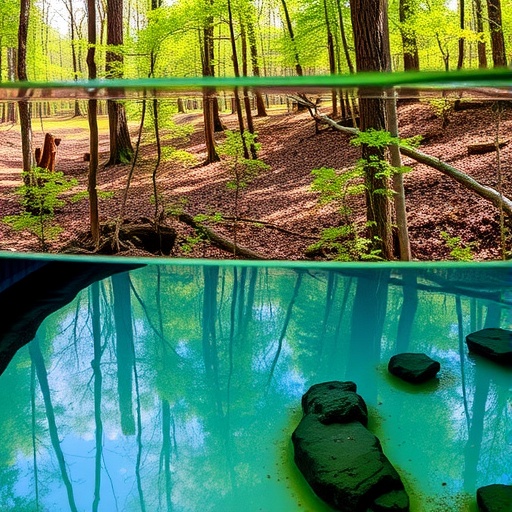Recent advancements in the field of geology and hydrology have provided new insights into the complex sedimentation processes that have shaped the Quaternary Mississippi River Valley alluvial aquifer. As a critical resource for millions, understanding the origins and evolution of this aquifer is vital for sustainable management and preservation efforts. The groundbreaking study led by Song, Tsai, and Minsley, published in “Commun Earth Environ,” delves into the quantitative characterization of the subsurface, revealing the dynamic interactions that feed into this essential aquifer.
Substantial evidence suggests that the Mississippi River Valley’s geological history dates back thousands of years, with its sedimentary layers revealing invaluable information about climatic changes and hydrological dynamics over time. The researchers employed an array of advanced geophysical techniques to meticulously map the subsurface structures. These techniques, including seismic reflection and ground-penetrating radar, enabled the identification of distinct stratigraphic layers that narrate the valley’s ancient geological story. The complexity of these sediment layers is indicative of various depositional environments, showcasing the river’s oscillating flow conditions due to climatic shifts.
Through their quantitative approach, the authors meticulously detailed sediment properties, including grain size distribution and permeability, which play a crucial role in water storage and flow dynamics within the aquifer. The study places significant emphasis on understanding how these sediment characteristics influence the aquifer’s capacity to store and transmit groundwater. Such insights are pivotal, especially given the growing water demand in the region. As cities expand and populations grow, safeguarding groundwater resources becomes increasingly critical.
Notably, the research highlights the origin of the sediment that forms the aquifer. The Mississippi River transported sediments from various upstream regions, contributing to the accumulation of rich alluvial deposits. This process not only highlights the interconnectedness of river systems but also underscores the impact of upstream land use on downstream water quality and availability. As agricultural practices and urban developments proliferate in these regions, understanding sediment transport dynamics can help inform better land management strategies that prioritize the sustainability of this vital resource.
Furthermore, the research sheds light on how these geological formations have been influenced by past glacial and interglacial periods. Evidence suggests that glacial meltwater significantly contributed to the sediment load transported by the river, leading to the formation of the aquifer we see today. By piecing together this historical narrative, the study provides a comprehensive framework that links geological history with contemporary hydrological resources.
The authors also investigated the implications of climate variability on aquifer recharge and depletion rates. As climate change continues to alter precipitation patterns, its effects on groundwater systems are becoming increasingly pronounced. Understanding these relationships can help hydrologists and water resource managers devise adaptive strategies to mitigate the impacts of such fluctuations. The quantitative subsurface characterization approach adopted in this study serves as a foundational tool for such future research.
In addressing the management of the Mississippi River Valley aquifer, the research team advocates for the incorporation of groundwater modeling techniques that integrate their findings. By utilizing predictive models, stakeholders can better assess the long-term sustainability of groundwater resources, particularly in times of drought or increased extraction demands. Such models are crucial for developing informed policies that align with the ecological health of the region.
As we continue to rely on the Mississippi River Valley alluvial aquifer, it becomes imperative to acknowledge the threats posed by anthropogenic factors, such as pollution and over-extraction. This research contributes to the broader discourse on environmental conservation by emphasizing the need for multidisciplinary approaches to groundwater management. Collaborations between geologists, hydrologists, policymakers, and local communities can pave the way for innovative solutions to safeguard this invaluable resource for future generations.
The study’s findings also prompt a reevaluation of existing data and models used in groundwater resource management. Many traditional models do not account for the complexities and variabilities introduced by evolving sediment characteristics and landscape changes. These insights empower water resource managers to adapt their strategies to consider the dynamic nature of subsurface environments effectively.
Moreover, public engagement plays a critical role in the sustainable management of water resources. Educating communities about the importance of the Mississippi River Valley aquifer not only fosters greater appreciation but also encourages responsible water use and conservation practices. Through initiatives aimed at raising awareness, stakeholders can cultivate a culture of sustainability and stewardship among residents.
In conclusion, the research conducted by Song, Tsai, and Minsley represents a significant leap forward in our understanding of the Quaternary Mississippi River Valley alluvial aquifer. By employing quantitative subsurface characterization techniques, the study uncovers the intricate relationships between geological history, sediment dynamics, and water resource management. As we face unprecedented challenges related to water scarcity and climate change, such research becomes crucial in guiding sustainable practices that ensure the longevity of vital aquifers and the ecosystems dependent on them. Engaging with these insights can pave the way for innovative approaches that harmonize resource use with environmental conservation, ultimately fostering a resilient future for both communities and natural systems alike.
Subject of Research: The Origin and Characterization of the Quaternary Mississippi River Valley Alluvial Aquifer
Article Title: Quantitative subsurface characterization illuminates the origin of the Quaternary Mississippi River Valley alluvial aquifer.
Article References:
Song, Y., Tsai, F.TC., Minsley, B.J. et al. Quantitative subsurface characterization illuminates the origin of the Quaternary Mississippi River Valley alluvial aquifer.
Commun Earth Environ 6, 646 (2025). https://doi.org/10.1038/s43247-025-02545-1
Image Credits: AI Generated
DOI: 10.1038/s43247-025-02545-1
Keywords: Mississippi River Valley, alluvial aquifer, groundwater management, sediment characterization, climate change, sustainable water resources.




